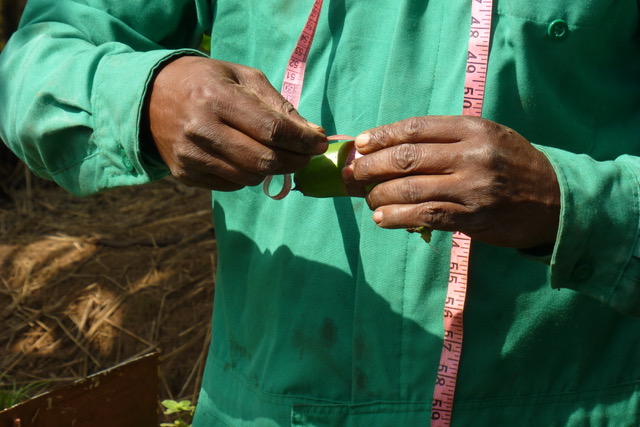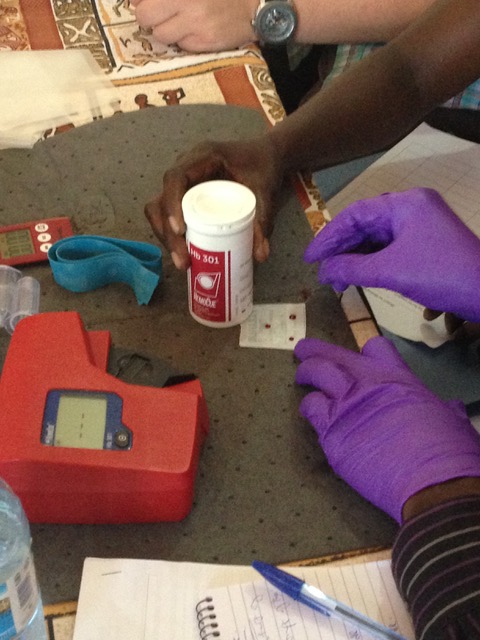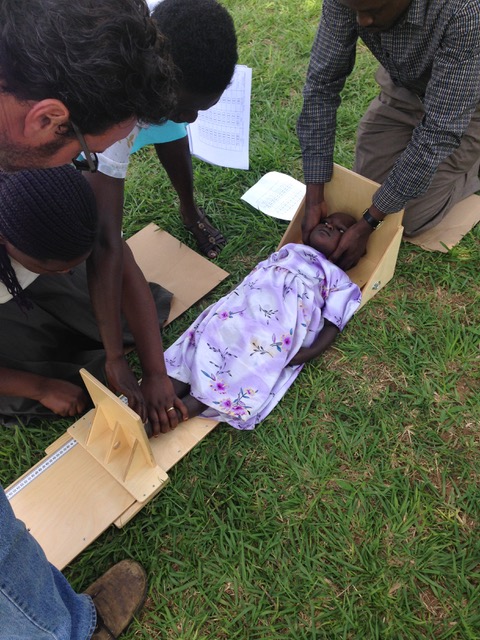Taking measures as end points?

An agronomist measuring the length and width of “fingers” of a new banana variety. Kawanda, Uganda (January 2016, S. Calkins)
An arm circumference that is too small, a waistline that is too wide, blood sugar levels that are too high. Measurements count among the powerful tools for ending long negotiations and establishing clear matters of fact. In the early twentieth century, Franz Boas, to whom this blog is dedicated, famously used measurements to disprove his contemporaries’ assumptions that race expresses itself in stable biological characteristics. He measured the cranial index of Southern European immigrant children in the US and found that the environment—and not race—affected such metrics (Boas 1912). The same measures were used for widely different ends, for both racist and antiracist projects. It was in fact Boas’s use of the established measurement technology—the cranial index—that was able to provide proof and quiet down racists fears about the impact of immigrants on an imagined “Northern” national gene pool. So yes, it seems there is some power in measurement to bring negotiations to an end (or at least to a provisional halt).[1] And surely this is what measurement should be able to do. This is why metrics were invented in the first place – to establish standards that can serve as a clear, objective and verifiable basis of comparison and thus dispel disagreement, doubt and guesswork. But are measures and standards really so reliable in bringing about a closure of controversies? In this short intervention I draw on ethnographic fieldwork with experts in the field of public health nutrition to nuance this assumption. I suggest much can be learned by paying close attention to their approaches to numbers and measurement methodologies.
Surely, any measures (think of the metric system) in use today are so commonplace and self-evident that they have indeed become black boxes. A black box implies that complicated forms of labor, ideas and materialities involved in the establishment of a standard become invisible and are taken for granted (Lampland & Star 2009). They hold together and enable focusing attention on other doings. A diabetic, for example, does not have to understand how a blood glucose meter works to measure her blood sugar levels. She only has to know how to operate its user interface. A black box has long seemed like a useful metaphor with which to think about negotiations that have provisionally ended. At the same, however, calling attention to black boxes has allowed STS scholars to work against established conventions and agreement. They do this through the iconoclastic gesture of opening the black box and unraveling a hidden world of disagreement and power struggles that lie beneath otherwise taken-for-granted standards (Callon and Latour 1981: 290).
Such and newer scholarship on quantification derives its critical edge from Foucault’s seminal work on the centrality of statistics to modern government. This literature in the social sciences has examined the basis for the widespread trust in numbers—the uncanny ability of numbers, indicators and statistics to translate politics into something seemingly apolitical, technical and neutral (e.g., Hacking 1990; Porter 1996). Work along these lines underscored the fact that numbers, statistics and indexes are central devices in structuring how attention is channeled to different issues. Numbers are advocacy tools but not only for those in power; they can also be used to critique government, garner support for a cause or frame a new problem. However, in recent years a growing sensibility for the vulnerability of measurement and quantification has leaked beyond academia into applied fields, like humanitarianism or development. Or perhaps the black box never was a black box for those working intimately with metrics (Biruk 2018; Straube 2020)?
This is certainly so for the field of public health nutrition that I have engaged in my research since 2015. Within in this field, there is a broad consensus that better metrics are needed, specifically on micronutrient deficiencies that are assumed to be major health concerns, especially during a child’s first 1000 days of life. What struck me as a permanent feature of many debates that I witnessed both at international conferences on nutrition and in Ugandan labs and public health efforts was health practitioners’ need for solid recommendations paired with a great deal of skepticism and critique about what was being done on the ground. While using measures in a positivist sense, those implementing nutrition programs in Uganda never believed that these numbers portray reality. Instead, they were often openly skeptical of applied measurement methodologies and the data they were responding to.

Collection of blood drops to measure the hemoglobin
levels during a nutrition intervention in Soroti,
Eastern Uganda, May 2015 (S.Calkins)

Taking a small child’s height measurements for
a nutritional intervention, Soroti, Eastern Uganda (May 2015, S.Calkins)
Similarly, at a roundtable at an international congress on “Hidden Hunger” that I attended in Stuttgart in 2015, a fault line emerged between those scientists studying the biochemistry of different micronutrients and applied nutritionists, who do community work in developing countries. Scientists working on specific micronutrients, like vitamin A, iodine or folic acid, debated a lack of evidence concerning micronutrient deficiencies, a data gap that they described as being vast. Questions they raised and debated were: When and how to measure the nutritional status? Should measures for single nutrients be used or should these be combined? What nutrients are needed, when, in what doses and for whom? What do new insights about the microbiome imply for how we measure nutritional absorption? A participant, whose self-serving and paternalistic self-description was being “more of a hands-on guy working with hungry people in Africa,” got up and addressed the panelists. He said that this was all very nice but that in the end: “we need clear messages from science, messages we can put into action”. He was referring to clear causal chains that would enable exposing failures and attributing blame. He said they needed evidence that allowed them to tell personalized stories “about Aisha”, who would not have been deaf if only she had gotten enough iodine, or “about Muhammad”, who would not have been blind had his mother received enough vitamin A. The panel members, however, rejected his request for closure. They stressed that nutritional science today still involved much guesswork, that the type of recommendations he desired were based on unreliable, often even nonexistent data. One speaker, a renowned pediatrician, even emphasized how little the development of malnutrition status indicators had advanced in recent years. She added that there were virtually no indicators of how to set and adjust micronutrient doses. Complexity and controversy let many in this field long for a closure but at least here no end of negotiations came into view.
A keynote speaker at the “Hidden Hunger” congress went so far as to claim that the status quo of anti-hunger measures hinged on the metrics. With urgency, he asserted that “what is not being measured is not being done”. He thereby pointed to the critical role of nutritional data and measurement in making micronutrient deficiencies visible and turning them into hotspots for global and public health interventions. In this speaker’s view and those echoed throughout the conference, the lack of data itself had become the main reason why global hunger remained an unfinished agenda and why solutions to the problem of micronutrient deficiencies were delayed. With this claim—that what is not being measured is not being done—the speaker pointed to the critical role of quantitative evidence in structuring what health issues become visible and are addressed by healthcare delivery. In other words, only those health issues and operations that are measured count in the end, regardless of what the people subsumed in these statistics or those treating them believe (Adams 2015).
As part of the international triumph of an evidence-based paradigm in politics, the enlightenment idea that everything—bodies, basic needs, economic growth, temperatures, sea levels, etc.—can be made measurable has proliferated widely. And along with it, the idea that we can only intervene if we get the figures and numbers right. Measurement derives its power from science that creates and legitimates metrics and in many ways this can be a means to end cumbersome social negotiations. However, measurement, while central to what we know about the world or “facts”—what we could argue are points of intermediate closure—is always also a terrain of negotiation (Biruk 2018). Even the accuracy of Franz Boas’s cranial index measurements and the conclusions he drew from them did not completely hold up over time. measurements have been challenged in terms of their statistical validity (Sparks and Jantz 2003), as well as by newer genetic technologies that re-biologize race (TallBear 2007).
Measurement and its role both in provisionally closing and in prompting new negotiations raise many thorny questions for ethnography and critique, especially when anthropologists can no longer claim to be opening the black box but merely relaying doubts and critiques that are already circulating. Indeed, the insight that measurements are performative and shape the social realities they purport to neutrally describe has disseminated beyond specialist academic discourse and is readily debated within many expert communities that anthropologists study. (Again, has this been there all along?) Thinking with the idea of the black box from my field sites in Uganda but also international public health discourses only captures one moment of agreement or provisional certainty in a broader oscillation, an oscillation between a results-oriented pragmatism that necessitates having to start somewhere and a deep skepticism of numbers and what they indicate about reality.
Sandra Calkins is Assistant Professor for Social and Cultural Anthropology at the Free University of Berlin. Her current research deals with postcolonial science, plants and humanitarian biotechnology in a Ugandan-Australian research collaboration.
Footnotes
References
Adams, V 2016. Metrics: What counts in global health. Duke UP.Biruk, C 2018. Cooking Data. Culture and politics in an African research world. Duke UP.
Boas, F 1912. Changes in the bodily form of descendants of immigrants. American Anthropologist 14(3): 530-62.
Callon, M and Latour, B 1982. Unscrewing the big Leviathan: how actors macro-structure reality and how sociologists help them to do. In Advances in Social Theory and Methodology: Toward an Integration of Micro-and Macro-Sociologies, ed. K Knorr-Cetina, 288-303.
Hacking, I 1990. The taming of chance. Cambridge UP.
Lampland, M and Star, LS 2009. Standards and their stories: how quantifying, classifying, and formalizing practices shape everyday life. Cornell UP.
Porter, T 1996. Trust in numbers: The pursuit of objectivity in science and public life. Princeton University Press.
Sparks, CS and Jantz, RL 2003. Changing Times, Changing Faces: Franz Boas’s Immigrant Study in Modern Perspective. American Anthropologist 105(2): 333-37.
Straube, T 2020. The black box and its dis/ contents: complications in algorithmic devices research. In Secrecy and Methods in Security Research, eds M Goede, E Bosma, P Lister-Wiilkins, 172-92. Routledge.
TallBear, K 2007. Narratives of Race and Indigeneity in the Genographic Project. Journal of Law, Medicine & Ethics 35(3): 412-24































